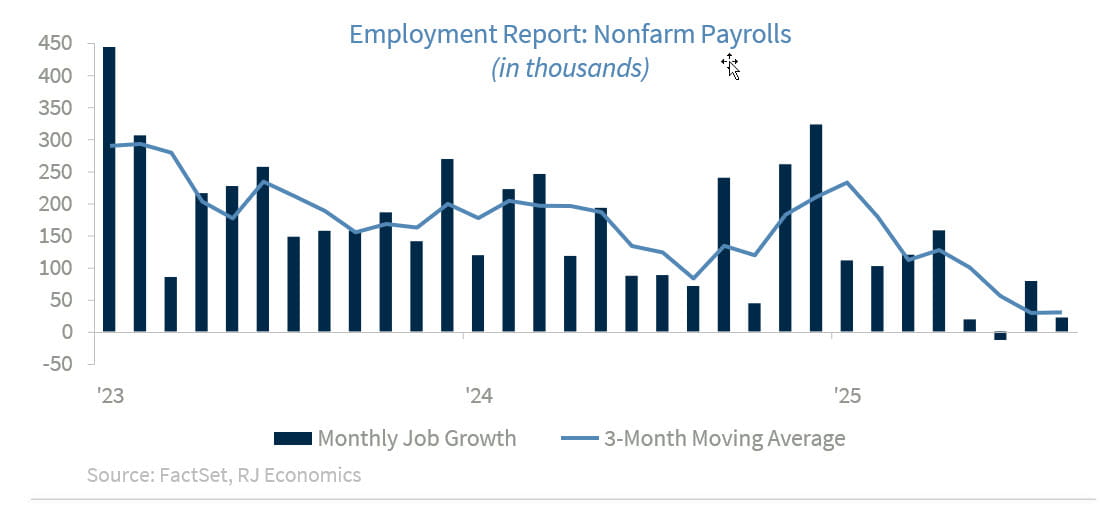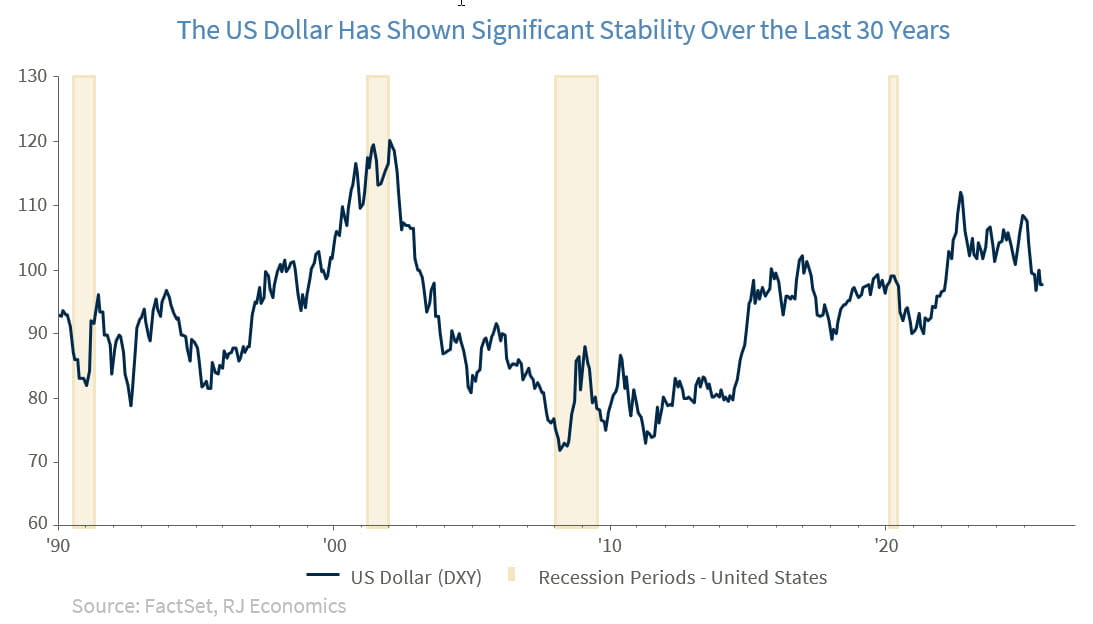Employment disappoints in August. Will the Fed disappoint in September?
- 09.05.25
- Economy & Policy
- Commentary
Chief Economist Eugenio J. Alemán discusses current economic conditions.
We are playing with our words in the title of this section. It is not that we believe the Federal Reserve (Fed) is not going to deliver a rate cut in September, because it will. The problem now is that markets may start pressuring the Fed to go for more than 25 basis points during the September meeting. Betting markets have started to move in that direction, and there are still 12 more days before the decision from the Federal Open Market Committee (FOMC).
Our biggest concern today is that if the labor market is as weak today as the numbers are showing, what will happen when all the federal government workers, who were given the Fork in the Road as well as those who are waiting for the courts to determine their fate, start dropping out of the employment numbers at the end of the fiscal year and during the next several quarters.
Furthermore, next week, on September 9, 2025, the Bureau of Labor Statistics is going to release the preliminary benchmark revision to the Establishment Survey, and there is the potential for even weaker employment from April 2024 until September of this year. Last year’s benchmark revision created lots of noise and showed a large negative number. Although there is no certainty that this year’s revisions will also be negative, the prospects for an even weaker employment profile during this year will be in line with our argument that the Fed should have moved to decrease interest rates during the first half of the year.
The decision from the FOMC will be determined during the next two weeks and will depend on whether Fed officials believe that the weakness in employment trumps the risks for higher inflation as tariffs continue to contaminate the inflation numbers.
Markets dismiss the threat to Fed independence at their own risk
Many commentaries over the last month have pointed to the lack of reaction from markets to the aggressive move by President Trump to fire Federal Governor Lisa Cook. This attempt followed several months in which the president increased pressure on Fed Chairman Jerome Powell to lower interest rates. That pressure campaign had more impact on markets, so our view is that it seems markets are tired of reacting to these pressures from the administration, and when the accusations against Governor Cook came out, they just said “whatever.” We understand markets’ indifference with the “whatever” part of it but disagree with the more serious potential consequences of giving in to political influence on determining interest rates. For more than three years in this position, we have been fighting every week against both serious concerns as well as highly questionable conspiracy theories regarding the fate of the US dollar, the fiscal deficit, the US debt, inflation, stagflation, the BRICS creating a new currency to compete against the US dollar, etc. Well, for those interested in these topics, everything boils down to monetary policy and Fed independence. That is, as long as there is an independent central bank that is ready to take the necessary measures to keep inflation low and stable, markets should not be concerned with the fate of the US dollar.
Of course, the fiscal deficit and the debt are important but those are the purview of fiscal policy, which is in the hands of the executive branch and the US Congress, not the Federal Reserve. That’s why every time Congress members ask a Fed Chairman/Chairwomen their view on fiscal issues they say they are not in a position to opine about fiscal policy. They do, sometimes, say that the debt is growing too fast or that the debt is too high, but they shy away from making inroads into how to fix it.
This does not mean that monetary policy does not have its effects on the fiscal side of the policy equation; it does. Just as the fiscal side also has implications for monetary policy. But this does not mean that the political system should get involved in determining interest rates. Furthermore, determining interest rates is the most important monetary policy instrument, and although politicians, firms, and individuals (with perhaps the exception of those who are living off a fixed income) prefer lower interest rates, lower interest rates are not always what an economy needs.
But most importantly, the Fed only controls one interest rate in the market, the federal funds rate, which is an overnight rate. The rest of the rates are determined by markets. Thus, the Fed has little control over what longer-term rates are. The only thing it can do is to make the right call at the right time on short-term interest rates and keep inflation expectations, especially in the long term, as low as possible and as close to its inflation target as possible.
Long-term interest rates are determined by demand and supply of funds, by inflation, by inflation expectations, by the term premium, by monetary policy expectations, by economic growth, by fiscal policy, etc. Presidential wishes are not included in determining long-term interest rates. But in those countries where the political system has tried to control monetary policy by eviscerating/eliminating the independence of their central banks, citizens and firms in those countries have had to pay the consequences. And in every one of these episodes, the consequences have been calamitous, with surging inflation/hyperinflation, debasement of currencies, balance of payment crises, debt defaults, and every other economic ailment that anybody could possibly imagine.
Economic and market conditions are subject to change.
Opinions are those of Investment Strategy and not necessarily those of Raymond James and are subject to change without notice. The information has been obtained from sources considered to be reliable, but we do not guarantee that the foregoing material is accurate or complete. There is no assurance any of the trends mentioned will continue or forecasts will occur. Past performance may not be indicative of future results.
Consumer Price Index is a measure of inflation compiled by the US Bureau of Labor Statistics. Currencies investing is generally considered speculative because of the significant potential for investment loss. Their markets are likely to be volatile and there may be sharp price fluctuations even during periods when prices overall are rising.
Consumer Sentiment is a consumer confidence index published monthly by the University of Michigan. The index is normalized to have a value of 100 in the first quarter of 1966. Each month at least 500 telephone interviews are conducted of a contiguous United States sample.
Personal Consumption Expenditures Price Index (PCE): The PCE is a measure of the prices that people living in the United States, or those buying on their behalf, pay for goods and services. The change in the PCE price index is known for capturing inflation (or deflation) across a wide range of consumer expenses and reflecting changes in consumer behavior.
The Consumer Confidence Index (CCI) is a survey, administered by The Conference Board, that measures how optimistic or pessimistic consumers are regarding their expected financial situation. A value above 100 signals a boost in the consumers’ confidence towards the future economic situation, as a consequence of which they are less prone to save, and more inclined to consume. The opposite applies to values under 100.
Certified Financial Planner Board of Standards Center for Financial Planning, Inc. owns and licenses the certification marks CFP®, CERTIFIED FINANCIAL PLANNER®, and CFP® (with plaque design) in the United States to Certified Financial Planner Board of Standards, Inc., which authorizes individuals who successfully complete the organization’s initial and ongoing certification requirements to use the certification marks.
Links are being provided for information purposes only. Raymond James is not affiliated with and does not endorse, authorize or sponsor any of the listed websites or their respective sponsors. Raymond James is not responsible for the content of any website or the collection or use of information regarding any website's users and/or members.
GDP Price Index: A measure of inflation in the prices of goods and services produced in the United States. The gross domestic product price index includes the prices of U.S. goods and services exported to other countries. The prices that Americans pay for imports aren't part of this index.
Employment cost Index: The Employment Cost Index (ECI) measures the change in the hourly labor cost to employers over time. The ECI uses a fixed “basket” of labor to produce a pure cost change, free from the effects of workers moving between occupations and industries and includes both the cost of wages and salaries and the cost of benefits.
US Dollar Index: The US Dollar Index is an index of the value of the United States dollar relative to a basket of foreign currencies, often referred to as a basket of U.S. trade partners' currencies. The Index goes up when the U.S. dollar gains "strength" when compared to other currencies.
The FHFA HPI is a broad measure of the movement of single-family house prices. The FHFA HPI is a weighted, repeat- sales index, meaning that it measures average price changes in repeat sales or refinancings on the same properties.
Import Price Index: The import price index measure price changes in goods or services purchased from abroad by U.S. residents (imports) and sold to foreign buyers (exports). The indexes are updated once a month by the Bureau of Labor Statistics (BLS) International Price Program (IPP).
ISM Services PMI Index: The Institute of Supply Management (ISM) Non-Manufacturing Purchasing Managers' Index (PMI) (also known as the ISM Services PMI) report on Business, a composite index is calculated as an indicator of the overall economic condition for the non-manufacturing sector.
The ISM Manufacturing Index: The GDP Now Institute of Supply Management (ISM) Manufacturing Measures the health of the manufacturing sector by surveying purchasing managers at manufacturing firms. The survey asks about current business conditions and expectations for the future, including new orders, inventories, employment, and deliveries.
Consumer Price Index (CPI) A consumer price index is a price index, the price of a weighted average market basket of consumer goods and services purchased by households.
Producer Price Index: A producer price index (PPI) is a price index that measures the average changes in prices received by domestic producers for their output.
Industrial production: Industrial production is a measure of output of the industrial sector of the economy. The industrial sector includes manufacturing, mining, and utilities. Although these sectors contribute only a small portion of gross domestic product, they are highly sensitive to interest rates and consumer demand.
The NAHB/Wells Fargo Housing Opportunity Index (HOI) for a given area is defined as the share of homes sold in that area that would have been affordable to a family earning the local median income, based on standard mortgage underwriting criteria.
Conference Board Coincident Economic Index: The Composite Index of Coincident Indicators is an index published by the Conference Board that provides a broad-based measurement of current economic conditions, helping economists, investors, and public policymakers to determine which phase of the business cycle the economy is currently experiencing.
Conference Board Lagging Economic Index: The Composite Index of Lagging Indicators is an index published monthly by the Conference Board, used to confirm and assess the direction of the economy's movements over recent months.
New Export Index: The PMI New export orders index allows us to track international demand for a country's goods and services on a timely, monthly, basis.
Gold is subject to the special risks associated with investing in precious metals, including but not limited to: price may be subject to wide fluctuation; the market is relatively limited; the sources are concentrated in countries that have the potential for instability; and the market is unregulated.
The Conference Board Leading Economic Index: Intended to forecast future economic activity, it is calculated from the values of ten key variables.
Source: FactSet, data as of 7/25/2025



